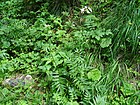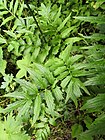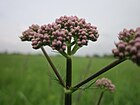Note: This is a project under development. The articles on this wiki are just being initiated and broadly incomplete. You can Help creating new pages.
Difference between revisions of "Valeriana officinalis"
(Created page with "{{stub}} ==Uses== {{Uses|}}, {{Uses|}}, {{Uses|}}, {{Uses|}}, {{Uses|}}, {{Uses|}}, {{Uses|}}, {{Uses|}}, {{Uses|}}, {{Uses|}}, {{Uses|}}.<ref name="Uses"/> ==Parts Used== {{...") |
|||
| Line 1: | Line 1: | ||
| − | + | [[File:20130530Baldrian Altlussheim1.jpg|thumb|right]] | |
| + | '''Valeriana officinalis''' is a perennial plant that can grow up to 1.50 metres tall. It is harvested from the wild for local use as a food, medicine and source of materials. | ||
==Uses== | ==Uses== | ||
| − | {{Uses|}}, {{Uses|}}, {{Uses|}}, {{Uses|}}, {{Uses|}}, {{Uses|}}, {{Uses|}}, {{Uses|}}, {{Uses|}}, {{Uses| | + | {{Uses|Nervous overstrain}}, {{Uses|Blood pressure}}, {{Uses|Painful menstruation}}, {{Uses|Cramps}}, {{Uses|Hypertension}}, {{Uses|Irritable bowel syndrome}}, {{Uses|Liver problems}}, {{Uses|Eczema}}, {{Uses|Ulcers}}, {{Uses|Minor injuries}}.<ref name="Uses"/> |
==Parts Used== | ==Parts Used== | ||
| Line 7: | Line 8: | ||
==Chemical Composition== | ==Chemical Composition== | ||
| − | <ref name="chemical composition"/> | + | This plant is rich in essential oils, iridoids, flavonoids, alkaloids, amino acids, and lignanoids etc.<ref name="chemical composition"/> |
==Common names== | ==Common names== | ||
| Line 16: | Line 17: | ||
===Dravya=== | ===Dravya=== | ||
===Rasa=== | ===Rasa=== | ||
| − | |||
===Guna=== | ===Guna=== | ||
| Line 29: | Line 29: | ||
==Habit== | ==Habit== | ||
| − | {{Habit|}} | + | {{Habit|Perennial}} |
==Identification== | ==Identification== | ||
| Line 48: | Line 48: | ||
==Mode of Propagation== | ==Mode of Propagation== | ||
| − | {{Propagation|}} | + | {{Propagation|Seeds}} |
==How to plant/cultivate== | ==How to plant/cultivate== | ||
| − | <ref name="How to plant/cultivate"/> | + | A very easily grown plant, it succeeds in ordinary garden soil, preferring a rich heavy loam in a moist site.<ref name="How to plant/cultivate"/> |
==Commonly seen growing in areas== | ==Commonly seen growing in areas== | ||
| − | {{Commonly seen|}}, {{Commonly seen|}}, {{Commonly seen|}}, {{Commonly seen| | + | {{Commonly seen|Grassland}}, {{Commonly seen|Scrub}}, {{Commonly seen|Woods}}, {{Commonly seen|Damp soils}}. |
==Photo Gallery== | ==Photo Gallery== | ||
<gallery class="left" caption="" widths="140px" heights="140px"> | <gallery class="left" caption="" widths="140px" heights="140px"> | ||
| − | + | Atlas roslin pl Kozłek lekarski 375 8149.jpg | |
| + | Atlas roslin pl Kozłek lekarski 7129 8149.jpg | ||
| + | Atlas roslin pl Kozłek lekarski 7130 8149.jpg | ||
| + | 20130516Baldrian Hockenheimer Rheinbogen2.jpg | ||
| + | 20130530Baldrian Altlussheim1.jpg | ||
| + | 20130530Baldrian Altlussheim2.jpg | ||
</gallery> | </gallery> | ||
| Line 64: | Line 69: | ||
<references> | <references> | ||
| − | <ref name="chemical composition">[ | + | <ref name="chemical composition">[https://www.hindawi.com/journals/ecam/2015/947619/ Chemical costituents]</ref> |
| − | <ref name="Leaf">[ | + | <ref name="Leaf">[Morphology]</ref> |
| − | <ref name="How to plant/cultivate">[ | + | <ref name="How to plant/cultivate">[http://temperate.theferns.info/plant/Valeriana+officinalis+ Cultivation]</ref> |
<ref name="Uses">Indian Medicinal Plants by C.P.Khare</ref> | <ref name="Uses">Indian Medicinal Plants by C.P.Khare</ref> | ||
</references> | </references> | ||
==External Links== | ==External Links== | ||
| − | * [ ] | + | * [https://www.webmd.com/vitamins/ai/ingredientmono-870/valerian Valeriana officinalis on webmd.com] |
| − | * [ ] | + | * [https://www.rxlist.com/valerian/supplements.htm Valeriana officinalis on rxlist.com] |
| − | + | ||
[[Category:Herbs]] | [[Category:Herbs]] | ||
Revision as of 17:44, 31 August 2020
Valeriana officinalis is a perennial plant that can grow up to 1.50 metres tall. It is harvested from the wild for local use as a food, medicine and source of materials.
Contents
- 1 Uses
- 2 Parts Used
- 3 Chemical Composition
- 4 Common names
- 5 Properties
- 6 Habit
- 7 Identification
- 8 List of Ayurvedic medicine in which the herb is used
- 9 Where to get the saplings
- 10 Mode of Propagation
- 11 How to plant/cultivate
- 12 Commonly seen growing in areas
- 13 Photo Gallery
- 14 References
- 15 External Links
Uses
Nervous overstrain, Blood pressure, Painful menstruation, Cramps, Hypertension, Irritable bowel syndrome, Liver problems, Eczema, Ulcers, Minor injuries.[1]
Parts Used
[[:Category:Herbs with used in medicine|]], stem, leaves, Root.
Chemical Composition
This plant is rich in essential oils, iridoids, flavonoids, alkaloids, amino acids, and lignanoids etc.[2]
Common names
| Language | Common name |
|---|---|
| Kannada | |
| Hindi | |
| Malayalam | |
| Tamil | |
| Telugu | |
| Marathi | |
| Gujarathi | |
| Punjabi | |
| Kashmiri | |
| Sanskrit | |
| English |
Properties
Reference: Dravya - Substance, Rasa - Taste, Guna - Qualities, Veerya - Potency, Vipaka - Post-digesion effect, Karma - Pharmacological activity, Prabhava - Therepeutics.
Dravya
Rasa
Guna
Veerya
Vipaka
Karma
Prabhava
Habit
Identification
Leaf
| Kind | Shape | Feature |
|---|---|---|
Flower
| Type | Size | Color and composition | Stamen | More information |
|---|---|---|---|---|
| {{{5}}} |
Fruit
| Type | Size | Mass | Appearance | Seeds | More information |
|---|---|---|---|---|---|
Other features
List of Ayurvedic medicine in which the herb is used
Where to get the saplings
Mode of Propagation
How to plant/cultivate
A very easily grown plant, it succeeds in ordinary garden soil, preferring a rich heavy loam in a moist site.[4]
Commonly seen growing in areas
Grassland, Scrub, Woods, Damp soils.
Photo Gallery
References
- ↑ Indian Medicinal Plants by C.P.Khare
- ↑ Chemical costituents
- ↑ [Morphology]
- ↑ Cultivation
External Links
- Ayurvedic Herbs known to be helpful to treat Nervous overstrain
- Ayurvedic Herbs known to be helpful to treat Blood pressure
- Ayurvedic Herbs known to be helpful to treat Painful menstruation
- Ayurvedic Herbs known to be helpful to treat Cramps
- Ayurvedic Herbs known to be helpful to treat Hypertension
- Ayurvedic Herbs known to be helpful to treat Irritable bowel syndrome
- Ayurvedic Herbs known to be helpful to treat Liver problems
- Ayurvedic Herbs known to be helpful to treat Eczema
- Ayurvedic Herbs known to be helpful to treat Ulcers
- Ayurvedic Herbs known to be helpful to treat Minor injuries
- Herbs with used in medicine
- Herbs with stem used in medicine
- Herbs with leaves used in medicine
- Herbs with Root used in medicine
- Habit - Perennial
- Index of Plants which can be propagated by Seeds
- Herbs that are commonly seen in the region of Grassland
- Herbs that are commonly seen in the region of Scrub
- Herbs that are commonly seen in the region of Woods
- Herbs that are commonly seen in the region of Damp soils
- Herbs






